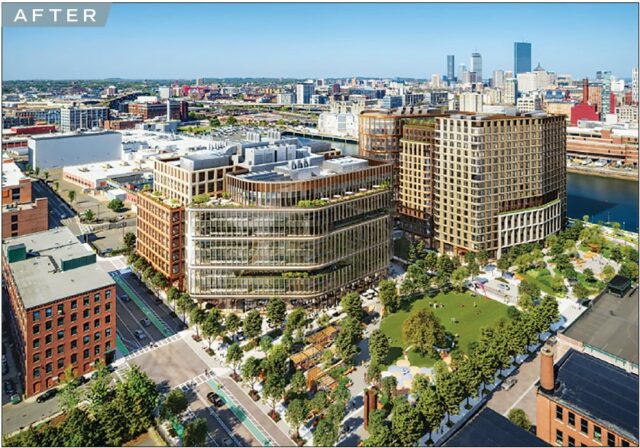
A piece of the Big Dig is forcing Related Beal to engage in complex engineering and shrink the footprint of its 244-284 A St. project. Image courtesy of KPF and Halvorson
Even in an old and crowded city such as Boston, the proposed Channelside project in Fort Point stands out as a particularly tricky development site.
Airport flight paths and waterfront zoning curtail future building heights on the 6-acre parking lot, which developer Related Beal bought in 2019 for $218 million. A less conspicuous constraint sits 10 feet beneath the asphalt: The roof of the Interstate 90 tunnel and a leaky construction joint that was repaired last year after Massachusetts Department of Transportation detected “signs of distress.”
Approval of the 1.1 million-square-foot Channelside development at 244-284 A St. hinges partly on whether Related Beal can satisfy MassDOT’s requirement that the three office, lab and residential buildings place no additional weight above the tunnel.
“It seems impossible, but it’s not,” Related Beal Executive Vice President Stephen Faber told an advisory group reviewing the designs at a public meeting in August. “What you have to do is some fairly sophisticated structural engineering, and that’s what we’re doing.”
Related Beal and its design team shaved a corner off one of the proposed buildings to comply with a MassDOT edict forbidding any construction above the tunnel’s “Superplug” joint, which underwent $3 million in repairs last year. The joint connects two structural elements of the Fort Point Tunnel section of I-90, which runs under Fort Point Channel and the Seaport District on its way to connect with the Ted Williams Tunnel and East Boston.
Complications caused by development above transportation networks are not unusual among recent developments in Boston. Developer Trinity Financial had to design its One Canal apartment tower in the West End to fit around a Central Artery Tunnel ventilation shaft and above MBTA Orange and Green Line tunnels. The MBTA Silver Line tunnel runs beneath several recent developments in the Seaport District. And HYM Investment Group recently cited complex tunnel and utilities discovered using 3D scanning in proposing changes to the next building at its Bulfinch Crossing project.

Image courtesy of the BPDA
MassDOT Has Veto Power
The limits on development at Channelside are part of an agreement that MassDOT signed with the previous owner, Gillette Co., two days before it sold the property to Related Beal in 2019. But MassDOT’s concerns about the tunnel date back at least to 2016, according to public records.
In September 2016, MassDOT sought approval from the Boston Conservation Commission to excavate 10 feet of soil in a three-quarter-acre section of the property that’s located above the 255-foot-long tunnel roof joint. The purpose: to conduct structural repairs of the Superplug.
“MassDOT highway division proposes to conduct remediation activities to address the continued water infiltration [leakage] into the SuperPlug section of the I-90 connector tunnel in the area below Gillette’s A Street parking lot,” the application states.
In October 2018, Gillette Co. hired JLL to market the 6.5-acre employee parking lot, one of the last remaining vacant parcels in the sought-after Seaport District, to prospective developers. Two days before the sale to Related Beal on May 15, 2019, MassDOT and Gillette Co. signed an agreement including an “overbuild manual” governing future design and construction on the property.
“While no design submissions have yet been made, MassDOT looks forward to participating in the design review process,” J. Lionel Lucien, manager of the MassDOT’s public-private development unit, wrote in a Sept. 11, 2020 memo.
With prospects for a large-scale development looming, MassDOT awarded a $2.9 million contract in February 2020 to Stoughton-based R. Zoppo Corp. to begin the seven-month repair project.

Image courtesy of KPF
A Change of Plans
The updated Channelside plans currently under review by Boston Planning & Development Agency and state officials include several significant changes from the original filing from July 2020, which was submitted while the Superplug repair job was still under way.
Building footprints shrank by over 7,000 square feet, while public open space increased by 43 percent to 0.8 acres. All three building footprints were reconfigured, resulting in a nearly 19,000-square-foot decrease in structures that would sit above the tunnel. But that still leaves more than 1.3 acres of structures proposed above the highway, according to documents submitted to the BPDA.
So how to accomplish that without placing additional weight? According to a draft environmental impact statement, portions of the buildings will be built with trusses or transfer girders that redirect loads toward and into the tunnel walls or former slurry walls from the tunnel’s original construction.
Discussions between MassDOT and Related Beal have yielded additional requirements, according to the draft EIR: The developers will provide MassDOT with emergency access into the tunnel for future repairs through a passageway that emerges above-ground near the intersection of Binford and Necco streets. And no structures can sit within 5 feet of the Superplug.

Steve Adams
“They said, ‘Look: we don’t know if we’re ever going to open that up again, but we’re going to have to have access, and you’re not going to be able to build over it.’ And they have that kind of authority to say that relative to the underlying tunnel,” Faber told the advisory group. “So, we simply can’t build on that area and that has impacted our design.”
MassDOT spokeswoman Kristen Pennucci did not respond to questions submitted by Banker & Tradesman about the integrity and safety of the tunnel, and did not return a series of follow-up phone and emailed messages. Related Beal did not respond to a request for an interview and questions submitted through a public relations agency.
While the project still awaits MassDOT’s signoff and dozens of state and local permits for final approval, Related Beal appears confident that it can overcome the engineering challenges.
On its ChannelsideBoston.com site, the developer is already marketing 735,000 square feet of office and life science space through brokerage JLL available beginning in July 2023, touting Channelside as the next location “Where History is Made.”




 |
| 
